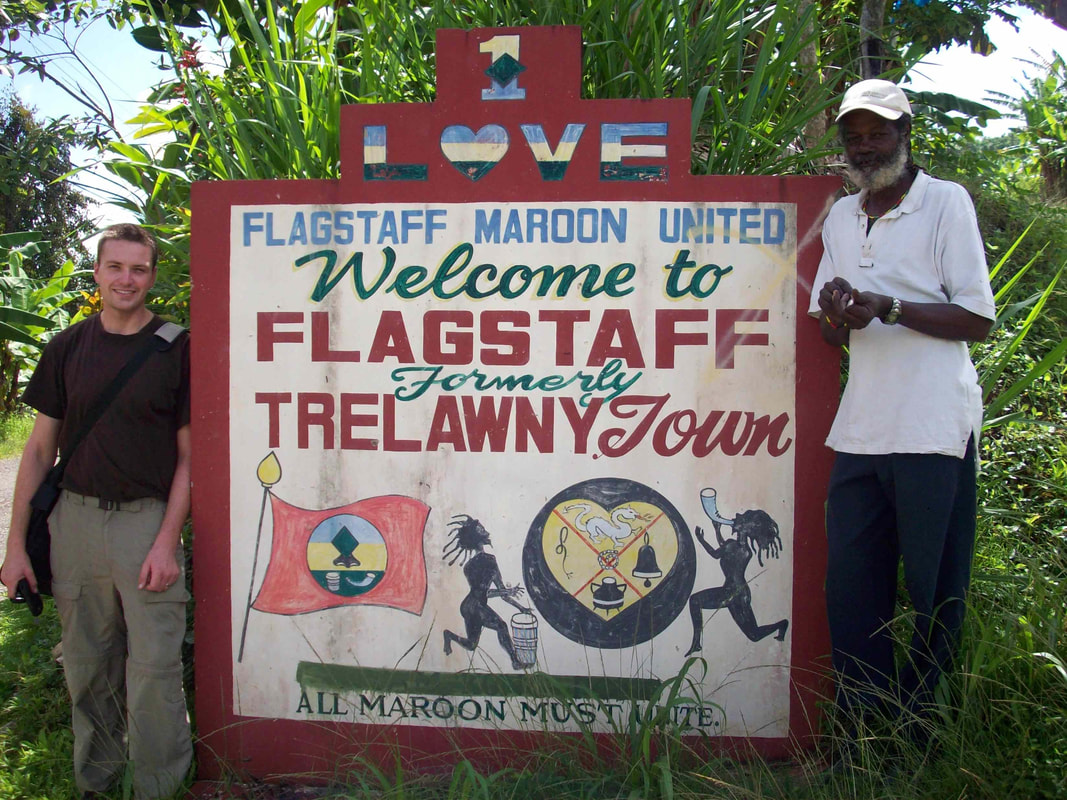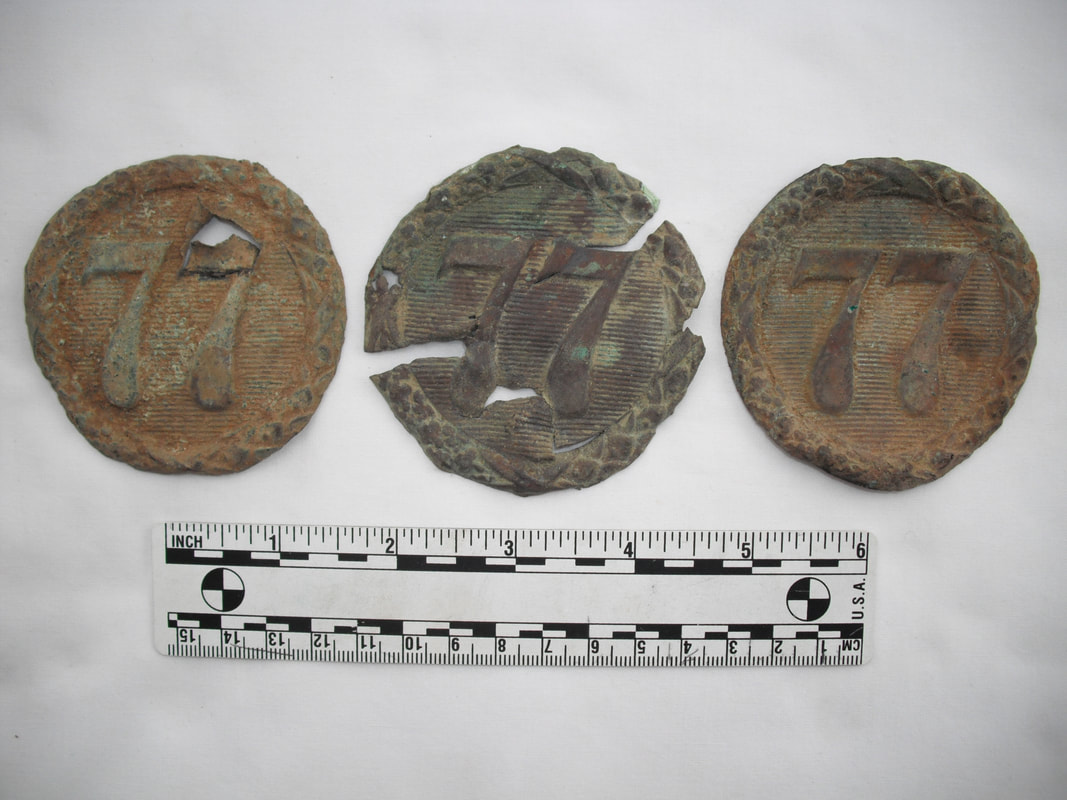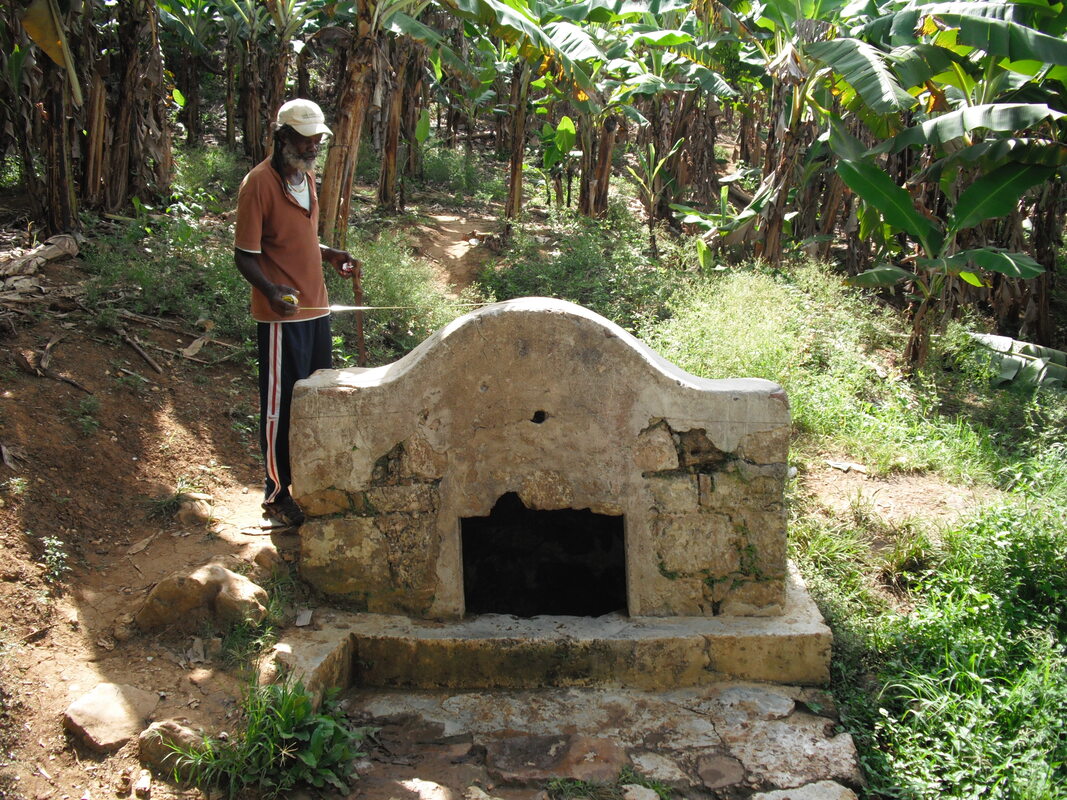|
This is a success story in the making. Specifically, this is a story about a small farming village in Jamaica, and about the development of a community based research agenda there. This is also the story about how a group of people from different backgrounds came together, as fellow students of history, and how we united in friendship and solidarity. This is our story and we are writing it together. We are Nicole Ferguson, an eco-heritage tour guide in Flagstaff, Jamaica, and David Ingleman, an anthropology graduate student at the University of California Santa Cruz (UCSC). We became friends and research partners several years ago, when David was a US Peace Corps Volunteer in Flagstaff. Flagstaff, a community of about 1,100 people, is located in Jamaica’s Cockpit Country—a rugged and trackless landscape typified by karst topography. Flagstaff was founded about three centuries ago by a group of self-emancipated African descendant people, called Maroons. Historically, Flagstaff had several names. The Maroons originally named their community Kojo Town, after their leader. From their mountain enclave in Kojo Town, the Maroons fought and won a war against their British enslavers, resulting in the Peace Treaty of 1739. During the treaty negotiations, the British renamed the community Trelawny Town, after the Governor of Jamaica. After decades of peace, war again erupted in 1795. Following the Second Maroon War, the Maroons were deported from Jamaica, first to Halifax, Nova Scotia, in 1796, and then in 1800, to Freetown, Sierra Leone. After the deportation, the area was occupied by British military units and renamed Maroon Town Barracks. They positioned the British flag on a high point, which could be seen from long distances; after emancipation, the barracks closed and the community became known as Flagstaff. Many Sierra Leonean Maroons and their descendants eventually returned to Jamaica and some decided to reoccupy their ancestral homeland in the Cockpit Country. Now the Maroon flag, as well as the Jamaican, Nova Scotian, and Sierra Leonean flags fly over Flagstaff. Like its modern name, Flagstaff’s landscape was shaped largely by the 19th-century British military occupation of the area. Artifacts dating to this period, including ceramics, pipe stems and bowls, buttons, glass bottles, and ammunition, are visible over much of Flagstaff. Many farmers have artifact collections, which we, working through the Cockpit Country Local Forest Management Committee (CCLFMC), have begun to identify, document, and catalog. In addition, some of the infrastructure constructed during this period is still in regular use, including many of the roads and paths, a swimming pool carved into the limestone bedrock, a limestone-entombed well, and several cut-limestone building foundations, which still support occupied superstructures. The former parade ground is now the football and cricket field and is known as Garrison Park. In contrast, Maroon heritage sites are identified primarily through oral tradition and associations with natural landmarks; interestingly, few if any artifacts have been observed on the surface of these sites. Nevertheless, the modern inhabitants of Flagstaff literally walk in their ancestors’ footsteps and tell their children vivid stories about what took place in Flagstaff centuries ago. The herbalists of Flagstaff are well known for their medicinal treatments, which is another legacy of their long association with the land. The rich cultural heritage and biodiversity of Flagstaff also has excellent potential for sustainable income generation. The CCLFMC recently launched the Flagstaff Heritage Tour and Trails Project, which guides visitors on three eco-heritage tours of the community: the Maroon Trail, Dragoon Hole Trail, and the Cemetery Trail. Visitors take in spectacular views, as well as learn about the local heritage and ecology from Flagstaff residents, including Nicole. The tourism product in Flagstaff encourages meaningful interaction with the local residents; visitors are invited to sample the local cuisine, enjoy traditional music, and purchase sustainably made handicrafts, and fresh, organic produce. The management of heritage resources in Flagstaff, though intellectually rewarding, is both difficult and expensive. Experience has taught us that heritage management requires both local and scholarly expertise, as well as friendships that can span continents. Facebook helps too. For example, many adults in Flagstaff migrate internationally to find work, which leads to reduced inter-generational transmission of oral histories, amongst other problems. In response, the CCLFMC initiated an oral history documentation project, sponsored by the Commonwealth Foundation and the British Council. Nicole, David, and Kenute Cameron, a Flagstaff elder, recorded interviews with more than 70 Maroons and Maroon descendants in Jamaica and Sierra Leone (http://maroonconnection.blogspot.com/). This effort resulted in a documentary film titled “Kojo’s Legacy: Rekindling the True Spirit of Our Ancestors,” (https://www.youtube.com/watch?v=dYz9QHm3P0Y) which was Nicole, David, Kenute, and Michael Shaw, the President of the Flagstaff Heritage Tour and Trails and member of the Trelawny Town Maroon Council co-wrote and co-directed. As the population of Flagstaff continues to grow, and the number of households increases, archaeological resource management is also becoming an increasing concern. Unfortunately, virtually no archaeological work has ever been conducted there. In the face of these challenges, several community organizations have joined together to co-sponsor the Flagstaff Community Archaeology Project. Pending permit approval, the first phase of the project will entail a four-week excavation and artifact analysis at the site of a 19th-century British married soldier’s quarters, in preparation for construction of the Flagstaff Community Centre. The Centre is located on the edge of Garrison Park, which was formerly the Maroon Town Barracks parade ground. Archival records suggest that married soldiers and their families at Maroon Town Barracks lived in a row of wattle and daub “huts,” located in the approximate location of the Community Centre. Because no contemporary married soldier sites have been previously excavated in the Caribbean, and the historical record offers few clues about whom the soldiers married, or what daily life was like for married soldiers and their families, this site is considered to have great research potential. The field crew for this project will include David, Nicole, Kenute, and four other volunteers from Flagstaff. Though we are optimistic about and dedicated to the success of this project, the heritage resources in Flagstaff are world-class treasures and should be of concern to everyone. That is why we are asking you to become a partner in the preservation of Flagstaff’s heritage, to visit us in Jamaica, or to make a donation to our Kickstarter campaign (https://www.kickstarter.com/projects/flagstaff/flagstaff-community-centre-archaeology-project?ref=discovery). Written by: Nicole Ferguson and David Ingleman About the authors: Nicole Ferguson resides in Flagstaff, Jamaica, where she is an active member of the Cockpit Country Local Forest Management Committee (CCLFMC) and a tour guide for the Flagstaff Heritage Tour and Trails. In 2011 Miss Ferguson traveled to Freetown, Sierra Leone as part of the Trans-Atlantic Maroon Connection Project. She will participate in the Flagstaff Community Centre Archaeology Project in August and September 2015 as an excavator and lab assistant. David Ingleman is an anthropology doctoral student at the University of California Santa Cruz, and the director of the Flagstaff Community Archaeology Project, in Flagstaff, Jamaica, and the President of Friends of Jamaica Peace Corps Association. Before attending graduate school, David worked as a professional archaeologist for several years in the United States. From 2008-2010, David served as an environmental business advisor in Peace Corps-Jamaica.
0 Comments
Leave a Reply. |
|



